Yokai Kijo (Kidjo): Demoness, Cannibal With Hideous Heart Is A Moral Reminder In Japanese Beliefs
A. Sutherland - AncientPages.com - The narratives surrounding the mythical female demons, known as 'kijo', carry a profound moral lesson: women who engage in unethical or immoral conduct risk transforming into malevolent entities that feast on humans.
Image credit: Adobe Stock - cegli 222
Kijo (or Kidjo) is a demoness, a cannibal woman usually wearing rags. In the beautiful beliefs of Japanese people, she is a yokai ("Yōkai") like thousands of other yokai figures.
The younger ones are called "kijo" while the ones that look like old ladies are called onibaba ("demon hag"). Kijo is usually huge but sometimes can be small. They are ugly; their appearance may vary; some of these monsters have (red or yellow eyes, blue skin, sharp horns, long claws, and dirty, matted hair.
These entities possess the extraordinary ability to shapeshift into alternative humanoid forms. As beautiful young ladies, they can be very dangerous trying to charm men. They also exhibit an insatiable craving for human flesh, which can be classified as an addiction. These beings are endowed with various supernatural characteristics that defy conventional understanding.
What did happen to these women?
Vengeful women turn into demons. According to Japanese folk tradition, women who have been betrayed by their husbands or abused or mistreated girls and grandmothers can turn into demons or monsters.
However, the term 'kijo' predominantly refers to females who have undergone a metamorphosis from human beings into monstrous entities, either as a consequence of committing terrible crimes, succumbing to uncontrollable and perilous jealousy, or harboring intense hatred and malice.
The print depicts the herione Kiyohime in distress on the banks of the Hidaka River. Chikanobu Toyohara, The Boatman, 1898. Triptych from the Bamboo Knots (Take no Hitofushi) series. Public Domain
Such highly negative feelings and actions influenced by them undoubtedly corrupt the pure soul. These individuals, having forsaken the rules of polite society, sought refuge in isolated dwellings such as abandoned residences or secluded mountain caverns or even made use of wandering along desolate roads under the veil of darkness.
This yokai's only goal is to continue committing evil deeds. Extremely powerful and dangerous, Kijo demonesses are skilled in the secrets of magic. They are highly capable of casting spells and brewing deadly poisons and potions.
Kijos do not act in groups. Instead, they prefer to act alone and are often driven by personal motives. Japanese legends say that they act either as persecutors of sinners in the underworld or as a threat to human society in the human world.
A particular moral lesson dominates in all stories about the Kijo demoness. It says that women who do bad things can become evil creatures, and men who follow them and succumb to their charm may ruin their lives or encounter their ultimate demise.
There are countless legends of Kijo female monsters in Japanese folklore. Most of them, however, were not created to scare people but as entertainment, warnings, or moral reminders.
Generally, 'Kijo' can be defined as a designation for any demonic or supernatural entity of the feminine gender with malevolent or otherworldly characteristics that can be found within various cultural traditions.
Section of the scroll Dojoji Engi Emaki illustrating the story where the serpent burns the bell killing the monk. Image credit: Unknown author - Dojo-ji engi emaki - Date : Muromachi period (16th) - Wakayama Prefecture, Japan. Public Domain
One of the most famous legends of Kijo demons in Japanese folklore is the tale of Kiyohime. According to this ancient narrative, Kiyohime was the daughter of Shaji, the respected leader of a village. Their family was popular and respected for extending hospitality to travelers passing through their community.
Kiyohime And Unreturned Love
The tale of Kiyohime and Monk Anchin explores the complexities of unreturned love.
Kiyohime, a village maiden, fell in love with a monk, Anchin, who once visited her village. The monk responded to Kiyohime's affections, but it was more on an aesthetic level, admiring her beauty.
Unfortunately, he did not want to pursue a deeper, more passionate connection with the girl. Driven by her intense emotions, Kiyohime decided to pursue the monk, which finally caused a tragic end.
Legend says that the monk escaped to the banks of the Hidaka River, begging the sailors to refrain from helping the girl cross the river. Kiyohime did not want to give up her pursuit. Consumed by her wrath, she decided to swim across the river herself. As she entered the currents, something extraordinary happened. Her fury manifested in a remarkable transformation, causing Kiyohime to assume the form of a serpent.
The monk Anchin saw this and took refuge in a temple, asking the temple to hide him in a bell. It did not help much. Kiyohime followed him and found the bell. Spitting fire through her mouth, she melted the bell and killed the monk. Kiyohime is considered a snake woman who kidnaps men in villages.
Written by – A. Sutherland - AncientPages.com Senior Staff Writer
Copyright © AncientPages.com All rights reserved. This material may not be published, broadcast, rewritten or redistributed in whole or part without thexpress written permission of AncientPages.com
More From Ancient Pages
-
 Unique 8,400-Year-Old Burial Of A Dog Different From Modern Dogs Discovered In Sweden
Archaeology | Sep 25, 2020
Unique 8,400-Year-Old Burial Of A Dog Different From Modern Dogs Discovered In Sweden
Archaeology | Sep 25, 2020 -
 Sword-Kladenets – Hidden Treasure Awaiting A Worthy Hero
Featured Stories | Feb 15, 2021
Sword-Kladenets – Hidden Treasure Awaiting A Worthy Hero
Featured Stories | Feb 15, 2021 -
 Secretly Engraved Woman Name Discovered In Medieval Manuscript – Who Was Eadburg?
Archaeology | Dec 3, 2022
Secretly Engraved Woman Name Discovered In Medieval Manuscript – Who Was Eadburg?
Archaeology | Dec 3, 2022 -
 Runic Inscription On The Forsa Ring Is Not What We First Thought – Scientists Say
Archaeology | Aug 15, 2024
Runic Inscription On The Forsa Ring Is Not What We First Thought – Scientists Say
Archaeology | Aug 15, 2024 -
 2,500-Year-Old Olmec Related Mexican Cave Paintings Are Now Restored And Protected
Civilizations | Sep 18, 2015
2,500-Year-Old Olmec Related Mexican Cave Paintings Are Now Restored And Protected
Civilizations | Sep 18, 2015 -
 God Ptah ‘Lord Of Memphis’ Was Among The Most Revered Creator Gods Of Ancient Egypt
Egyptian Mythology | Apr 17, 2018
God Ptah ‘Lord Of Memphis’ Was Among The Most Revered Creator Gods Of Ancient Egypt
Egyptian Mythology | Apr 17, 2018 -
 What Happened To The Pythagorean Brotherhood?
Ancient History Facts | Apr 5, 2021
What Happened To The Pythagorean Brotherhood?
Ancient History Facts | Apr 5, 2021 -
 Mysterious Hieroglyphs Point To The Location Of Queen Nefertiti’s Tomb?
Archaeology | Sep 29, 2022
Mysterious Hieroglyphs Point To The Location Of Queen Nefertiti’s Tomb?
Archaeology | Sep 29, 2022 -
 Cooper’s Ferry Site In Western Idaho Was Inhabited 16,000 Years Ago
Archaeology | Sep 3, 2019
Cooper’s Ferry Site In Western Idaho Was Inhabited 16,000 Years Ago
Archaeology | Sep 3, 2019 -
 Huge Ptolemaic/Roman Funerary Structure Unearthed In Egypt’s Fayoum
Archaeology | Dec 6, 2022
Huge Ptolemaic/Roman Funerary Structure Unearthed In Egypt’s Fayoum
Archaeology | Dec 6, 2022 -
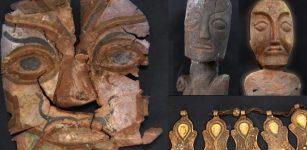 Golden And Silver Facial Ornaments, Wooden Figurines Among The Finds In Tomb Of Tibetan Plateau
Archaeology | Dec 28, 2020
Golden And Silver Facial Ornaments, Wooden Figurines Among The Finds In Tomb Of Tibetan Plateau
Archaeology | Dec 28, 2020 -
 1,800-Year-Old Relief Of Mythological Satyr Figure Under Restoration
Artifacts | Sep 5, 2020
1,800-Year-Old Relief Of Mythological Satyr Figure Under Restoration
Artifacts | Sep 5, 2020 -
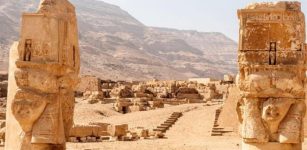 Cache Of 13,000 Ostraca Unearthed In Upper Egypt’s Sohag
Archaeology | Dec 21, 2021
Cache Of 13,000 Ostraca Unearthed In Upper Egypt’s Sohag
Archaeology | Dec 21, 2021 -
 Prehistoric Brits Used Rare Rock Crystals To Mark Burial Sites – New Study
Archaeology | Aug 10, 2022
Prehistoric Brits Used Rare Rock Crystals To Mark Burial Sites – New Study
Archaeology | Aug 10, 2022 -
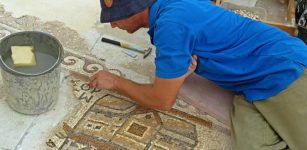 A Rare 1,500 Year Old Mosaic That Depicts Ancient Streets And Buildings in Egypt – Discovered
News | Sep 29, 2015
A Rare 1,500 Year Old Mosaic That Depicts Ancient Streets And Buildings in Egypt – Discovered
News | Sep 29, 2015 -
 Book Of Deer And The Lost Scottish Monastery – Archaeologists Report New Finds
Archaeology | Jan 10, 2018
Book Of Deer And The Lost Scottish Monastery – Archaeologists Report New Finds
Archaeology | Jan 10, 2018 -
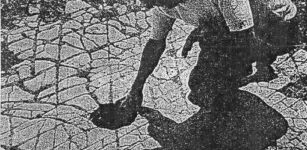 Oklahoma’s Ancient Mosaic Floor With Mysterious ‘Post Holes’ Could Re-Write History Of North America
Civilizations | Aug 10, 2018
Oklahoma’s Ancient Mosaic Floor With Mysterious ‘Post Holes’ Could Re-Write History Of North America
Civilizations | Aug 10, 2018 -
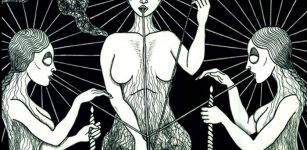 Goddesses Of Fate And Destiny In Greek, Roman And Slavic Mythologies
Featured Stories | Sep 28, 2017
Goddesses Of Fate And Destiny In Greek, Roman And Slavic Mythologies
Featured Stories | Sep 28, 2017 -
 Skeleton Of Irish Giant Charles Byrne Will Not Be Displayed In The Hunterian Museum In London
Historical Figures | Jan 13, 2023
Skeleton Of Irish Giant Charles Byrne Will Not Be Displayed In The Hunterian Museum In London
Historical Figures | Jan 13, 2023 -
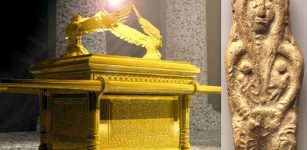 Was A Statue Of Asherah Hidden In The Ark Of The Covenant?
Artifacts | Dec 26, 2017
Was A Statue Of Asherah Hidden In The Ark Of The Covenant?
Artifacts | Dec 26, 2017



